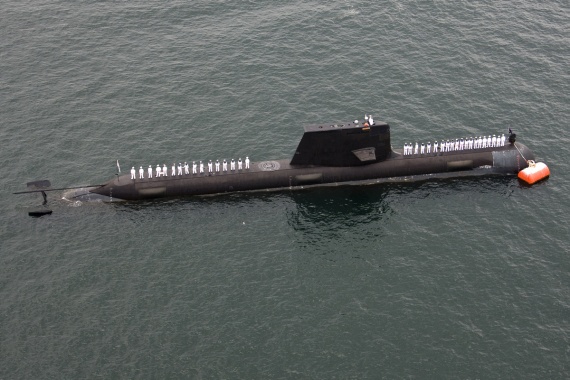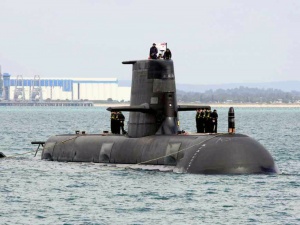
HMAS Farncomb at anchor during Fleet Divisions in March 2009.
Based at Fleet Base West in Western Australia, HMAS Farncomb is the second of the 6 Collins Class submarines to enter service in the Royal Australian Navy (RAN). These submarines are a formidable element in Australia's defence capability.
Farncomb was launched in Adelaide, South Australia by Rear Admiral Harold Farncomb's widow, Mrs Jean Farncomb on 15 December 1995 and commissioned in Fremantle, Western Australia on 31 January 1998.
HMAS Farncomb's operational characteristics and range have been tailored specifically for its defence and two-ocean surveillance role in the RAN. Designed to be as quiet as advanced technology can achieve, Collins class submarines have been developed from five generations of submarines designed and built by the Swedish Navy.
One of the first submarines to be totally designed by computers, Farncomb boasts a vast range of features. They include a high-performance hull form, highly automated controls, low indiscretion rates, high shock resistance, optimal noise suppression and an efficient weapons handling and discharge system.
The submarine moves silently on electric power supplied to the propulsion motor by banks of new technology lead-free batteries. The batteries are charged by three onboard diesel generator sets.
The sophisticated combat system gathers its intelligence from its sensors, computes the input and then launches and directs weapons.
Since commissioning, Farncomb has successfully conducted a range of activities throughout the region in support of Australian Defence Force exercises, operations and the government's strategic directives.
Farncomb is named after Rear Admiral Harold B Farncomb CB DSO MVO RAN who distinguished himself in action during the Second World War. He commanded HMAS Canberra (I) in 1941 when the ship forced two German raider support ships to scuttle while on Indian Ocean patrol. Later, aboard HMAS Australia (II) he saw action in the Coral Sea, Guadalcanal, the East Solomons, Arawe and Cape Gloucester. He assumed temporary command of His Majesty's Australian Squadron when Commodore Collins was wounded aboard the HMAS Australia (II) at Leyte in 1944. He commanded the Squadron in operations at Corregidor, Brunei and Balikpapan.
Specifications
 |
| Class |
Collins Class |
|---|---|
| Type |
Guided Missile Submarine, Diesel-Electric (SSG) |
| Pennant |
S74 |
| International Callsign |
VMLF |
| Motto |
With Skill And Resolve |
| Home Port |
Fleet Base West |
| Builder |
Australian Submarine Corp, Adelaide |
| Laid Down |
1 March 1991 |
| Launched |
15 December 1995 |
| Launched by |
Mrs Jean Farncomb (widow of Rear Admiral Harold Farncomb) |
| Commissioned |
31 January 1998 |
| Dimensions & Displacement | |
| Displacement |
|
| Length | 77.8 metres |
| Beam | 7.8 metres |
| Draught | 7 metres |
| Performance | |
| Speed |
|
| Range |
|
| Complement | |
| Crew |
|
| Propulsion | |
| Machinery |
|
| Armament | |
| Missiles | McDonnell Douglas Sub Harpoon Block 1B (UGM 84C); active radar homing |
| Torpedoes | 6-21 in (533 mm) fwd tubes. Gould Mk 48 Mod 4/6/7; dual purpose; wire-guided; active/passive homing |
| Mines | 44 in lieu of torpedoes. |
| Physical Countermeasures | Decoys: 2 SSE. |
| Electronic Countermeasures | ESM: Condor CS-5600; intercept and warning. |
| Radars | Navigation: Kelvin Hughes Type 1007; I-band. |
| Sonars |
|
| Weapon Control Systems | AN-BYG 1. Link 11 |
| Resources | |
| News Articles |
Defence News |
| Image Gallery |
HMAS Farncomb |